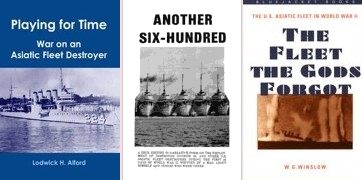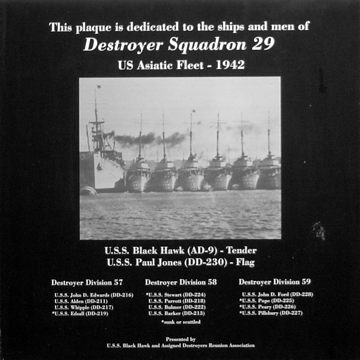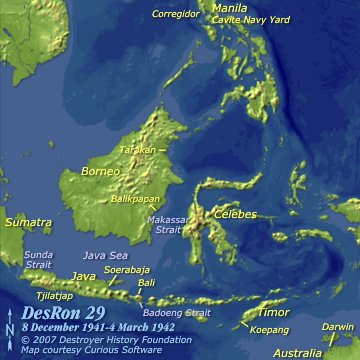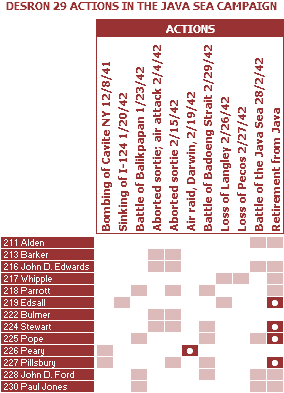“Old enough to vote,” said Adm. Thomas C. Hart, Commander in Chief, US Asiatic Fleet of the thirteen destroyers under his command—Destroyer Squadron 29—“not only inadequately armed for the warfare of the day but sadly in need of overhaul,” yet “manned by rock-hard veterans of the China Station who, under relentless, nerve-racking pressure, fought them with fierce determination and courageous abandon against fearful odds* . . . ”
Destroyer Squadron 29
24 November 1941
USS Paul Jones, DD 230, flag
Destroyer Division 57
USS
Whipple, DD 217, flag
USS
Alden, DD 211
USS
John D. Edwards, DD 216
USS Edsall, DD 219
Destroyer Division 58
USS Stewart, DD 224, flag
USS
Parrott, DD 218
USS
Bulmer, DD 222
USS
Barker, DD 213
In 1941, the Asiatic Fleet was a navy all to itself. All of its thirteen destroyers had been stationed in the Far East beginning in 1922. Over the next 19 years, they had conducted disaster relief missions to Japan following earthquakes in 1923 and ’25 plus diplomatic and rescue missions stemming from an unsettled political situation in Asia. During this time, none of them had returned to the United States or been modified on station: with the exception of of jury-rigged sonar, they were equipped as first commissioned.
The men, too, were an unusual breed. Most had served with the Atlantic or Pacific Fleets for then-standard 2½-year tours. Many were single, without strong family ties. Hand-picked in many cases for transfer to the Asiatic Fleet, where they might be expected at any time to represent the United States far from home, they were well-drilled, disciplined and—of necessity—resourceful.
Since the Japanese invasion of China in 1937, they had been on a virtual war footing. They deployed 24 November 1941 as divisions:
- DesDiv 57—Whipple (DD 217, flagship), Alden (DD 211), John D. Edwards (DD 216) and Edsall (DD 219)—with destroyer tender Black Hawk (AD 9) to Balikpapan, Borneo.
- DesDiv 58—Stewart (DD 224, flagship), Barker (DD 213), Parrott (DD 218) and Bulmer (DD 222)—with squadron flagship Paul Jones (DD 230) and Omaha-class cruiser Marblehead to Tarakan.

Lodwick H. Alford’s Playing for Time is the perspective of an officer of DesDiv 58 flagship Stewart from before the war through her abandonment in dry dock in Java in February 1942 and subsequent capture and recommissioning by the Japanese, with background information on DesRon 29.
Another Six-Hundred—likening DesRon 29 to Tennyson’s The Charge of the Light Brigade—by J. Daniel Mullin, the Asiatic Fleet’s reunion coordinator and others who were there, is the story of the employment of Destroyer Division 59 and other Squadron 29 destroyers during the first 85 days of the war.
W. G. Winslow’s The Fleet the Gods Forgot provides a broader, non-destroyer-specific view of the same subject.
- DesDiv 59—Pope (DD 225) and flagship John D. Ford (DD 228) patrolled from Manila while Peary (DD 226) and Pillsbury (DD 227) were under repair from collision at Manila’s Cavite Navy Yard.
News of the Japanese attack on Pearl Harbor reached them on the morning of the same day—now 8 December—a few time zones to the west. John D. Ford and Pope immediately left Manila Bay escorting oilers Pecos (AO 6) and Trinity (AO 13) and seaplane tender Langley (AV 3). Hours later, Japanese aircraft attacked Cavite, hitting Peary.
RETREAT
There followed a retreat to the Malay Barrier. Attached to Task Force 5 which was concentrating to Soerabaja (Surabaya), Java, Divisions 57 and 58 fell back without incident, followed on 26 December by
Pillsbury and
Peary, the last large ships to get out.
Peary’s retirement—to Darwin, Australia rather than Soerabaja—was dramatic. Stopping twice to camouflage herself, she was attacked by both Japanese and Australian planes. Despite a disabled shaft, she made Darwin 3 January 1943, only to discover that 28 members of her crew had contracted malaria en route.
DEFENSE
During the remainder of January, DesRon 29’s thirteen destroyers engaged in defensive patrol and escort duties and achieved some small successes. Operating from Soerabaja, with a rear base at Tjilatjap (Cilacap) on Java’s south coast:
- On 20 January, Edsall sank submarine I-124 while she and Alden were escorting oiler Trinity (AO 13) near Darwin.
- On the 23rd, DesDiv 59 (John D. Ford, Parrott, Paul Jones and Pope) attacked the Japanese invasion force off Balikpapan, sinking four anchored cargo-transports and a patrol craft; only Ford was damaged.
In February, however, the tide turned:
- On the 4th, DesDiv 58 (Stewart, Edwards, Barker and Bulmer) were attached to a multinational force under Dutch Adm. Doorman, which sortied to attack transports in Makassar Strait but turned back when bombers attacked the formation, damaging cruisers Houston (CA 30) and Marblehead (CL 21).
- On the 12th in fog, Whipple collided with the Dutch cruiser De Ruyter. The next day she made Tjilatjap; damage was minor.
- On the 15th, Adm. Doorman again sortied to attack an invasion force off Sumatra, but aborted the mission after being bombed for six hours. Stewart, Barker, Bulmer, Edwards, Pillsbury and Parrott formed part of the screen; damaged by near misses, Barker and Bulmer retired to Exmouth Bay, Australia and did not subsequently figure in the campaign.
- On the 19th, Ford, Pope, Parrott, Edwards, Stewart and Pillsbury with Dutch cruisers and destroyers, again under the operational orders of Adm. Doorman, sortied from Soerabaja 100 miles to the east, hoping to break up landings at Bali. In the resulting Battle of Badoeng (Badung) Strait, Stewart and Dutch cruiser Tromp were damaged and Dutch destroyer Piet Hein was sunk. Stewart retired and entered drydock at Soerabaja.
- That same day, Peary was sunk during a massive air raid at Darwin.
- On the 26th, Edsall and Whipple sortied from Tjilatjap to escort Langley, ferrying P-40 fighter aircraft, back into port. When Langley was bombed and abandoned, the two destroyers took off survivors and Whipple took the derelict hulk under gunfire before retiring.
- Off Christmas Island south of Java the next day, Edsall and Whipple transferred Langley survivors to Pecos and then stood off. A radio message from Pecos indicating she was under air attack brought Whipple back in time to rescue some survivors from the water; Edsall was never heard from again.
- Also on the 27th north of Soerabaja, Edwards, Alden, Ford, Pope and Paul Jones participated in the 7-hour Battle of the Java Sea, a defeat that decided the outcome of the campaign.
RETIREMENT
As it was immediately clear that Java could no longer be held, the following day, 28 February, Adm. Helfrich ordered all ships to retire to Australia.
- While deep-draft Houston and Perth tried to escape to the west through Soenda (Sunda) Strait, where they were lost, Division 58—now Edwards, Alden, Ford and Paul Jones—sneaked out from Soerabaja to the east and turned south through shallow Bali Strait. Detected but not pursued as the broke into the open Indian Ocean, they arrived at Fremantle, Australia on 4 March.
- Departing Tjilatjap, Whipple and Parrott also succeeded in their runs south to Australia.
For the other DesRon 29 destroyers, the end came quickly:
- Pope, the only destroyer at Soerabaja with torpedoes remaining, sortied to the north on the 28th with cruiser HMS Exeter and destroyer HMS Encounter. Alone and surrounded in the Java Sea on 1 March after fighting off the Japanese surface forces that sank both British ships, Pope finally succumbed to bombers. None of her crew were lost in this action and 124 of her 151 officers and men returned from Japanese prison camps after the war.
- That same day, Edsall, Pillsbury and gunboat Asheville vanished on the run south from Java: Edsall was bombed and then sunk by gunfire from cruiser Chikuma that evening with only a few survivors (whose beheaded bodies were discovered postwar at the site of a Japanese prison camp); Pillsbury was sunk the following evening by cruisers Takao and Atago, which picked up no survivors; Asheville survived until 3 March.
- Stewart was still in drydock when Soerabaja was evacuated on 2 March. (Restored by the Japanese, she served in the war as a patrol boat before repatriation.)
Thus ended the Java Sea campaign.
DECORATIONS
Even before the Battle of the Java Sea, Adm. Doorman considered that crews had passed the limits of physical endurance. Notwithstanding, said Adm. Glassford, “ . . . fighting spirit and morale . . . continued to be of the highest order. Our deficiencies in material strength, as compared to the force brought to bear by the enemy, were offset in a larger measure than is perhaps realized by the steadfast spirit and morale of our officers and men, who, in general, maintained the highest traditions of the United States Navy.”
Compared with later practice, relatively few unit and individual awards were presented. Among them were the Presidential Unit Citation for John D. Ford and Pope and a Medal of Honor for Pope’s Lt. Richard Antrim who, while a prisoner of war at Makassar, Celebes, volunteered to take the remainder of an unconscious shipmate’s beating—one of four Medals of Honor awarded to destroyermen in World War II.
AFTERWARD
In 1943, five of the first nine
Edsall-class destroyer escorts were named for the five lost DesRon 29 destroyers:
Edsall (DE 129),
Robert E. Peary (DE 132),
Pillsbury (DE 133),
Pope (DE 134) and
Stewart (DE 238).
Pillsbury and
Pope received Presidential Unit Citations as part of the USS
Guadalcanal (CVE 60) task group.
Later in World War II, Destroyer Division 60 (Dallas, Ellis, Bernadou, Du Pont and Cole) took the designation DesDiv 59 when operating on the Pacific side of the Panama Canal.
All eight surviving DesRon 29 destroyers served in the Atlantic and were scrapped after the war.




